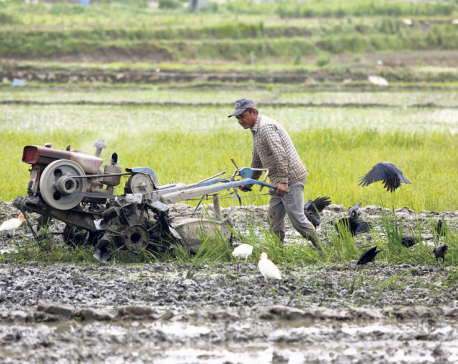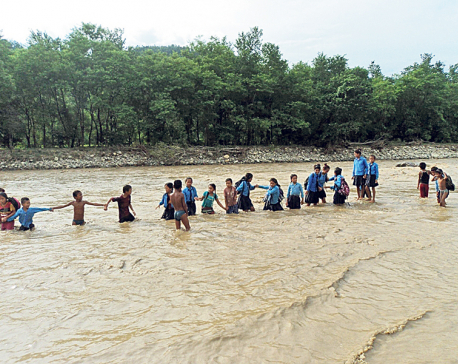
OR
More than 20 districts in Tarai have suffered damages from recent floods and agriculture has been worst-hit
Natural disasters such as earthquakes, floods, landslides and fires are taking place with troubling frequency in Nepal these days. Data shows that since 1970, the scale, intensity and frequency of floods have drastically increased. They also harm our economy. We are victims of both natural and as well as man-made disasters. Earthquakes killed thousands of people in the hills two years ago, Indian blockade caused a huge loss to our economy in 2015, and monsoon-induced floods have wrecked the entire Madhes this year.
Excessive rainfall along the lower reaches of the Himalayas was responsible for heavy floods in the Tarai this time. India-built infrastructures along Nepal-India border were also culpable, apart from mining and excavation works in our major river systems.
Monsoon in Nepal serves as a blessing at times and a curse at other times. When there is adequate rainfall, as in 2016, it proves to be a blessing. When there is too much or too little rainfall, it becomes a curse.
This year’s rainfall came as a curse. More than 20 districts in Tarai have suffered damages and agriculture has been the worst-hit. Due to natural and man-made disasters, annual loss of agriculture-based products has averaged over a billion rupees (see the table alongside). In this Nepal has failed to learn from its previous experience.
The total loss in agriculture due to recent Tarai floods is estimated at Rs 17 billion. Flooding has severely damaged 135 major irrigation projects including 15 major irrigation systems such as the Bagmati Irrigation Project, Narayani Irrigation System and Gandak West Canal. Crops worth Rs 3.64 billion have also been destroyed. Paddy crop was damaged the most, followed by vegetables and fisheries.
According to the Ministry of Livestock Development, 69,617 livestock, including goats, buffaloes, chickens and pigs, have been killed in the lowlands and thousands of livestock have been injured.
Before the floods, the Ministry of Agriculture Development (MoAD) had projected paddy output of 5.4 million tons this year by extrapolating from the record production of 5.2 million tons in the last fiscal. Thanks to the recent floods, this goal is sure to be missed, resulting in significant income loss for farmers. The import bill for agricultural products, which was close to Rs 200 billion last year, is also sure to increase.
Tarai serves as bread basket for rest of the country. As such this region needs to be safeguarded from flooding and inundation, for instance by providing for adequate waterways for the distribution of floodwater.
After the floods, farmers in Tarai are looking to purchase production inputs and tools to rebuild their livelihoods and to be better prepared for the next agriculture season. In this connection, the government relief package for farmers, in the form of subsidies on seeds, fertilizers and agriculture machinery, is timely. Since the winter is not far off, we also need to prepare for winter crops without any delay. These, however, are short-term measures.
For the long run, we must focus on better watershed management, river control and community-led development activities. Conservation of Chure hills through people’s participation, land use regulation to reduce vulnerability to flooding and inundation in Tarai, resettlement of certain communities, and adequate drainage to safely allow floodwaters to dissipate should be the other areas of focus.
Floods cannot be avoided but we can certainly be better prepared.
The government has been trying to reduce damages but its policies and implementation strategies are seldom effective. Government efforts are mostly concentrated on relief. For example, the government deployed over 26,000 people, including security personnel, in search and rescue operations. Seven choppers of Nepal Army and six helicopters of private companies along with rubber boats and motor boats were also mobilized.
But Nepal still lacks permanent institutional set-up that works for five Rs—Rescue, Relief, Risk-reduction, Resettlement and Research—which are vital for disaster management. The systems that are in place have failed to deliver, largely due to lack of coordination among governmental and non-governmental agencies. At present, the Ministry of Home Affairs is working as a nodal agency for disaster risk management.
Although the government adopted the National Strategy for Disaster Risk Management (NSDRM) in 2009 for prevention, mitigation, preparedness, response and recovery, a multi-sectoral institutional setup is still missing. There is limited investment in infrastructure that prevents flooding. The few infrastructures we have proven inadequate. Much more needs to be done to prevent loss of lives, crops and livestock during floods.
bhairabr@gmail.com
You May Like This

Paddy plantation completed on 20 percent of fields
KATHMANDU, July 1: According to the officials, plantation has been completed in 20.2 percent of the rice fields so far.... Read More...

Dependence on foreign fields for cooking oil still increasing
KATHMANDU, Nov 3: Nepal spends more than Rs 21 billion each year on imported cooking oil alone. And every year, the... Read More...

Children brave flooded river to reach school
KAPILVASTU, Sept 14: From the moment she sends off her children to school till they return home safely in the evening,... Read More...





Just In
- MoHP cautions docs working in govt hospitals not to work in private ones
- Over 400,000 tourists visited Mustang by road last year
- 19 hydropower projects to be showcased at investment summit
- Global oil and gold prices surge as Israel retaliates against Iran
- Sajha Yatayat cancels CEO appointment process for lack of candidates
- Govt padlocks Nepal Scouts’ property illegally occupied by NC lawmaker Deepak Khadka
- FWEAN meets with President Paudel to solicit support for women entrepreneurship
- Koshi provincial assembly passes resolution motion calling for special session by majority votes







_20220508065243.jpg)






Leave A Comment